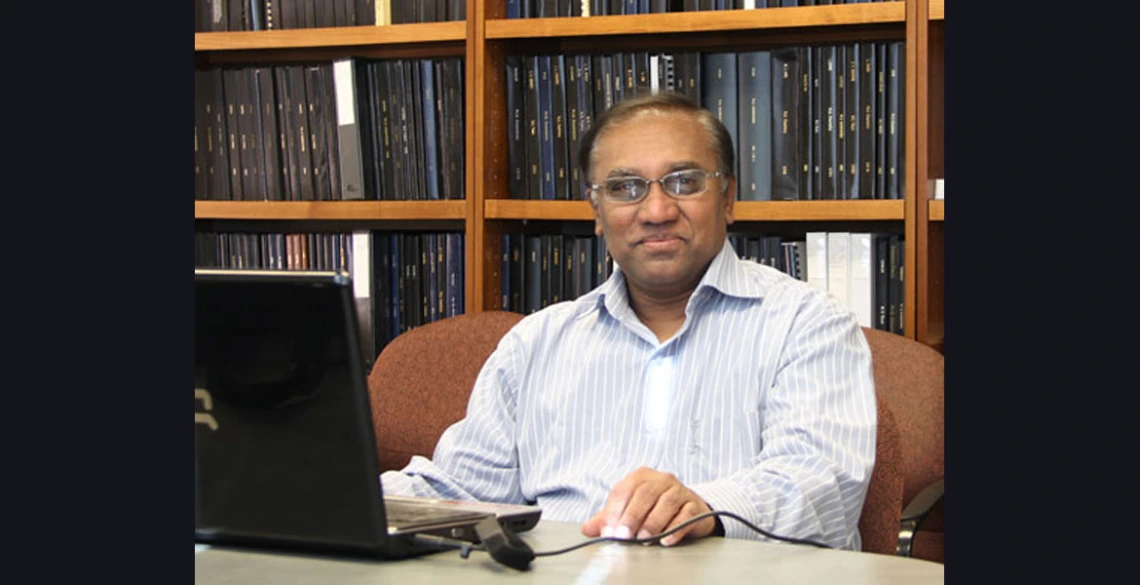$1.25 Million Rock Stability Research Project Could Make Mining and Construction Safer
A UA Engineering research program on new methods of determining rock strength could reduce hazardous working conditions that currently cause thousands of deaths every year in mining and construction.

Pinnaduwa H. S. W. Kulatilake, professor of geological engineering, with an emphasis on rock mechanics and rock engineering, in the UA College of Engineering.
A University of Arizona geotechnical engineer has been awarded $1.25 million to conduct research that could provide safer working conditions for miners and construction workers.
The true extent of mining fatalities globally is hard to gauge, but some estimates suggest that as many as 12,000 miners die every year in mine accidents. The primary cause of these fatalities is ground failure.
Ground failure is generally any significant movement of the ground, such as a landslide or underground excavation collapse, or when ground moves and flows like a liquid, which results when earthquakes or high water pressure cause soil to lose its strength.
Tunnel or underground cavern collapse and catastrophic failure of slopes, dams and foundations are examples of ground failure encountered in mining and civil engineering projects.
Part of the problem is that current methods of rock assessment are simply not up to the task of providing a detailed picture of what engineers are truly getting into when they start blasting and tunneling.
Pinnaduwa H. S. W. "Kumar" Kulatilake, professor of geological engineering in the UA College of Engineering, is the sole principal investigator for a five-year project to develop new methods of assessing ground stability. The National Institute for Occupational Safety and Health, which is part of the Centers for Disease Control and Prevention, is funding the research.
Ground stability depends on the strength and deformability of rock, which in turn depend on:
- What type of rock it is and how it behaves under certain conditions
- Presence of joints, fractures, and faults
- Stresses on the rock, such as pressure from overlying rock, or tectonic forces
- Groundwater conditions
- Stresses and forces present in the rock that will be released by excavation
The relationships between these factors are complex and it is difficult to determine rock strength and deformability, and thus ground stability, using the analysis techniques and limited field and laboratory investigations that are currently available.
During the 5-year project, Kulatilake will extend rock strength criteria he has developed to make them applicable in three-dimensions. He will be working with two mines in the U.S. and two mines in China to apply his new methodologies to underground and surface excavations to check how well they work in the real world. China's official mining death toll in 2010 was 2,631. It is the world's largest coal producer and consumer, and employs 5.5 million coal miners.
Kulatilake points out that it is not only miners who will benefit from being able to evaluate rock masses for potentially hazardous working conditions. "This is not only for mining," he said. "This work also relates to civil rock engineering projects such as tunnels, caverns, foundations, dams, and slopes."
To develop new methods of ground stability analysis, Kulatilake will combine field investigations and extensive laboratory testing, such as CT scans and three-dimensional load testing, with three-dimensional numerical modeling, including new theoretical concepts and advanced statistical and probabilistic procedures to quantify variability and uncertainty.
His theoretical models will be made increasingly accurate over time as their predictions are validated using lab test results and field data. In essence, Kulatilake aims to bring more certainty to what is essentially educated guesswork when it comes to assessing ground stability. "We have been using very simple methodologies in practice to address very complicated problems," he said.
Another part of the problem is that assessing ground stability and preventing ground failure are extremely difficult. Because the number of experts in this area is decreasing, along with funding to train their replacements, a dwindling number remain to conduct these challenging assessments.
In terms of creating a new generation of experts in this area, he expects the research to lead to the completion of seven doctoral dissertations. "We need to have some young blood," said Kulatilake. "It is time to create a new generation of mining professionals who are experts in ground control."
The research findings will be incorporated in graduate courses taught by Kulatilake in the department of mining and geological engineering and the department of civil engineering and engineering mechanics. And his teaching will extend beyond the University of Arizona: During the last 20 years he has taught 52 short courses all over the world.
Overall, Kulatilake expects his research results to provide a wealth of information related to excavations made for mineral extraction, tunnels for hydropower and transport, dams, foundations, natural and man-made slopes, underground caverns for oil and gas storage and human use, and hazardous waste isolation caverns.

